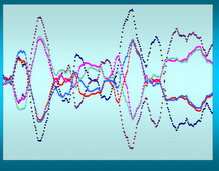These examples are for swing trading purposes. A swing trade is a trade that is normally taken over a period of days. Pivot point calculations can assist the swing trader in determining entry and exit points for the trade.
Step one – select a list of stocks you believe you would like to trade. In other words you don’t normally use the pivot point to find the stock – you use the pivot point to assist you in trading the stock.
Step two – calculate a set of pivot points for each stock selected in step one. Use the previous week’s high/low/close data for this purpose.
Step three – wait until one of your selected stocks crosses a support pivot point level – either S1 or S2 or midpoint low.
Example 1 – BIG. This is a stock that I identified in a post the other day from an article I read in Notable Calls. Here is how it behaved on Monday and Tuesday.

You can see that it opened and dropped right to S1 where it printed two Doji one of which being a higher low. A little while later it rebound from S1 and went over the course of the next two days to nearly R1 where, what else, it printed two Doji.
Example 2 – BLG. An old friend – and you can see it more or less did what BIG did.

Example 3 – MDRX. A stock I played last week and dropped out of after a small gain. Should have had it on the radar this week. Not quite all the way to S2 but to the midpoint between S1 and S2 which is just as good. You can, of course, wait till it crosses S1 (and note how it lingered there waiting for the traders to catch up. Then it went to the PP where it lingered some more and then it went to MPH. Will it go higher? I don’t know – today will tell.

Example 4 – QQQQ. I’m currently holding some from just above MPL which is where it is right now. I think it rebounds today and goes to MPH at least.

Example 5 – AMD. Some readers are talking about this – here is how it looks in Pivot Point View. S1 to MPH + already this week and on its way back. If it crosses MPH again this week it is probably going to R2 which is 17.93. If it goes back to S1 - then it starts all over again. Such is the swing trade world.

There you have it – five crisp and recent examples of possible swing trades using pivot points. The one thing you have to notice is the small amounts most stocks move from S1 to R1. This, of course, is a function of the initial price of the stock. The less costly the stock the smaller the expected move all things considered. And the word is “expected” there are no guarantees in this business.
And as a last word - you couldn't help but notice how all of the stocks up there, selected more or less at random, have a similar chart pattern. What that means to you is that if you pick a stock to watch and it starts hitting S1 and moving up there is good reason to believe that your other stocks are also hitting S1 and moving up. Then your only problem is picking the ones to play. And how do we do that? ATR is Volatility.
Now for your pleasure here are two sites that will help you calculate pivot points. Since you still have to enter the initial HLC values and then transcribe the results somewhere else you are probably better off doing it with an Excel spreadsheet.
pivotpointcalculator.comStepney Futures
































